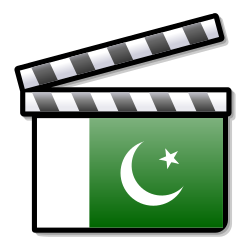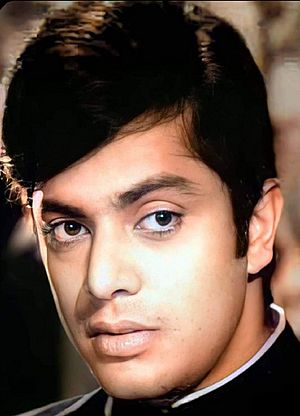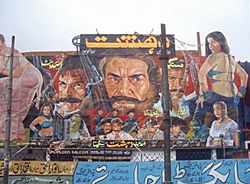Cinema of Pakistan facts for kids
Quick facts for kids Cinema of Pakistan |
|
|---|---|
 |
|
| No. of screens | 135 (2022) |
| Main distributors | ARY Films Hum Films Geo Films Urdu 1 Pictures Six Sigma Plus Eveready Pictures |
| Produced feature films (2023) | |
| Total | 100+ |
| Number of admissions | |
| Total | 250,000,000 |
Pakistani cinema, often called Lollywood, is the film industry in Pakistan. It's where movies are made! The main places for filmmaking are in big cities like Karachi, Lahore, and Faisalabad.
Pakistani movies are a big part of Pakistani culture. After some tough years, the film industry is growing again. It brings fun to people in Pakistan and to Pakistanis living in other countries. There are different film industries in Pakistan, often focusing on specific regions or types of movies.
Did you know that Joyland was the first Pakistani film shown at the famous Cannes Film Festival in 2022? It was also chosen to represent Pakistan at the 95th Academy Awards for Best International Feature Film!
Since 1948, over 14,000 Urdu movies have been made in Pakistan. Plus, thousands of films have been made in other languages like Punjabi, Pashto, Sindhi, and Balochi. The very first film ever made in the region was Husn Ka Daku in 1929. It was directed by Abdur Rashid Kardar in Lahore. The first film made after Pakistan became independent was Teri Yaad in 1948.
From 1947 to 2007, most Pakistani films were made in Lahore. This city was home to the biggest film industry, known as Lollywood. During this time, Pakistani movies were very popular. They were a big part of culture and watched by many people. In the early 1970s, Pakistan was actually the fourth-largest producer of feature films in the world!
However, between 1977 and 2007, the film industry faced challenges. New rules and stricter censorship made things difficult. Also, the quality of films sometimes went down. The industry struggled through the 1980s and 1990s. By 2000, filmmaking in Lahore had almost stopped. Many actors, actresses, and filmmakers moved from Lahore to Karachi.
By 2007, the film industry started to recover. Karachi became the new center for Pakistani cinema. New filmmakers began making short films with good stories and using new technology. This led to a fresh start for Pakistani movies. Many people believe this shift to Karachi helped the industry bounce back. Even with past challenges, Pakistani films have kept their unique style. Since moving to Karachi, Pakistani films have become very popular again.
Contents
- History of Pakistani Cinema
- Early Days: Silent Films (1929–1946)
- New Beginnings: Independence and Growth (1947–1959)
- The Golden Age of Pakistani Cinema (1959–1977)
- Challenges and Decline (1977–1990)
- The Industry Struggles (1990–2002)
- A New Hope: Revival and Resurgence (2003–2011)
- The New Wave of Pakistani Cinema (2011–Present)
- Pakistani Film Festivals
- Awards for Pakistani Films
- See also
History of Pakistani Cinema
Early Days: Silent Films (1929–1946)
The story of cinema in Pakistan began in 1929. That's when Abdur Rashid Kardar started a studio called United Players Corporation in Lahore. This studio became the start of the Lahore film industry. They set up their offices on Ravi Road. It was a simple setup, and they could only film during the day. But the area had beautiful spots like the Ravi Forest.
In 1929, Kardar made the first silent film in Lahore, called Husn Ka Daku (Mysterious Eagle). It was a mild success and showed that Lahore could make movies. Kardar decided to focus on directing instead of acting. His studio then released Sarfarosh in 1930 and Farebi Daku in 1931. These films helped the Lahore film industry grow.
In 1932, Roop Lal Shori made Qismat Ke Haer Pher (Life After Death). This film really helped establish Lahore as a strong film center. Later, in 1946, Sajjad Gul started Evernew Studios. The next year, Eveready Pictures was created. It became one of the biggest film companies in Pakistan.
New Beginnings: Independence and Growth (1947–1959)

After Pakistan became independent in 1947, Lahore became the main place for cinema. At first, there wasn't much money or equipment, which made filmmaking hard. But the first Pakistani movie, Teri Yaad, was released on August 7, 1948, in Lahore.
Over the next few years, movies had some success. Then, Do Ansoo was released on April 7, 1950. This film was a huge hit! It played in cinemas for 25 weeks, which was a big achievement. Filmmaking was clearly getting better. Noor Jehan directed Chanwey, released on April 29, 1951. This was special because it was the first film directed by a woman!
As more people watched movies, Sassi, released on June 3, 1954, became even more successful. It stayed in cinemas for 50 weeks! A famous singer named Ahmed Rushdi started his career in 1955. He sang his first song in Pakistan, "Bander Road Se Kemari." In 1956, Umar Marvi became the first Pakistani film made in the Sindhi language.
To celebrate these successes, a film journalist named Ilyas Rashidi started an awards event on July 17, 1957. These are the Nigar Awards, which are still important today for recognizing great work in Pakistani filmmaking.
The Golden Age of Pakistani Cinema (1959–1977)

The 1960s are known as the "golden era" for Pakistani cinema. Many new stars became legends during this time. Movies also started to be made in color! Some of the first color films included Azra in the early 1960s and Sangam in 1964. Sangam was the first full-length color film.
In 1962, the film Shaheed was released. It introduced Pakistanis to the Israeli–Palestinian conflict and was very popular. Also in 1962, the talented actor Mohammad Ali made his debut in Charagh Jalta Raha.
After the war between Pakistan and India in September 1965, all Indian films were banned. This actually helped Pakistani cinemas, as more people came to watch local movies.
Waheed Murad became a huge star during this time. People called him the "chocolate hero" because of his charming personality. In 1966, his film Armaan was released. It became one of the most loved Urdu films ever. This movie also helped start Pakistani pop music with famous singers like Ahmed Rushdi. Armaan was the first film to play for 75 weeks in cinemas across the country! Another rising star was Nadeem Baig, who became famous with his first film Chakori in 1967.
Horror films also started with Zinda Laash. This was the first Pakistani film to have an "R rating" warning on its posters. A popular magazine called Eastern Films Magazine kept film fans updated with news and stories.
Towards the late 1960s and early 1970s, there was some political unrest. But movies like Dosti, released in 1971, still did very well. Dosti played for 101 weeks, becoming the first film to reach "diamond jubilee" status. Filmmakers had to be careful about the messages in their movies. For example, in 1976, a mob set fire to a cinema in Quetta before the first Balochi film, Hammal O Mahganj, was released.
In 1976, Javed Jabbar's Beyond the Last Mountain was Pakistan's first English film. However, it didn't do well. Around this time, new technologies like VCRs and film piracy started to cause problems for the cinema industry.
Challenges and Decline (1977–1990)
Pakistani cinema faced a tough time during the rule of Muhammad Zia-ul-Haq (1978–1988). New laws and higher taxes made it harder for filmmakers and fewer people went to cinemas. Many cinemas in Lahore were even closed. VCRs and film piracy also hurt the industry.
Aina, released in 1977, was a huge success. It stayed in cinemas for over 400 weeks, playing for more than four years in Karachi! It's considered the most popular Pakistani film ever. But overall, the number of films made each year dropped a lot.
The film industry was almost collapsing. However, some films became big hits, like the Punjabi classic Maula Jatt in 1979. This movie was about a hero who fought a local gangster. Maula Jatt led to many films with similar themes. Another film, Aurat Raj (1979), was praised for its strong female characters. But new rules against showing affection in films meant that violent Punjabi movies became more common. This style of film was called the gandasa culture.
The romantic image of Pakistani cinema from the 1960s changed to a more violent one in the 1980s. Many middle-class people stopped watching these films. However, films in the Pashto language stayed popular, especially with refugees from Afghanistan. Punjabi films were also watched by young men from rural areas.
In 1983, the famous actor Waheed Murad passed away, which was another sad moment for the industry. Even Pakistan's first science fiction film, Shaani, in 1989, couldn't save the industry. It won awards internationally but wasn't successful in Pakistan.
The Industry Struggles (1990–2002)
By the early 1990s, Pakistan's film industry was in deep trouble. Many studios closed down, and the number of films made each year dropped significantly. Filmmakers often had to pay for their own productions. The loss of popular stars from the 1960s also made people less interested.
Some films tried to bring audiences back. Haathi Meray Saathi in 1998 was a success, playing for 66 weeks. Other notable films included Syed Noor's Jeeva (1995) and Choorian (1998), which earned a lot of money. In 1999, Inteha was a joint project with Russia.
Despite these efforts, the public didn't respond much. Low attendance at cinemas continued. By the early 2000s, an industry that once made 80 films a year was struggling to make even two. Some films like Larki Panjaban and Yeh Dil Aap Ka Huwa had some success, but it wasn't enough to fully revive the industry.
A New Hope: Revival and Resurgence (2003–2011)
Around 2003, young filmmakers in Karachi started trying new things. They made low-budget films to show that good movies could still be made in Pakistan. Cinemas were closing, and everyone wanted to see the film industry come back. A new TV channel called Filmazia began showing old Pakistani films and new low-budget ones.
In 2007, Shoaib Mansoor directed and released Khuda Ke Liye. This film was a big surprise hit! It brought middle-class audiences back to cinemas because it talked about important social issues in Pakistan. The film was also shown internationally, including in India, making it the first Pakistani film released there in 40 years. Many people see Khuda Ke Liye as the start of the cinema revival and Karachi becoming the center of Pakistani film.
Even with this success, progress was slow. In 2009, the "Pakistan New Cinema Movement" started to help filmmakers connect and make more movies. Several films were released after Khuda Ke Liye, but they had limited success. Then, Shoaib Mansoor came back with his 2011 film Bol, which broke box office records in Pakistan!
The New Wave of Pakistani Cinema (2011–Present)
Bol truly seemed to kickstart the "revival" of Pakistani cinema. In 2013, seven Pakistani films were shown in cinemas. This made people wonder if a "new wave" of Pakistani cinema was beginning. Since 2011, films like Waar and Main Hoon Shahid Afridi have become the highest-grossing Pakistani films.
2013 was a great year for Pakistani cinema. In March, Siyaah was the first horror thriller film released in Pakistan in over 20 years. It earned a good amount of money. The next month, Chambaili, a political thriller, was released. It aimed to encourage patriotism in Pakistan.
Waar was a huge winner in 2013. This action-thriller became the highest-grossing Pakistani film ever at the time! It showed events related to the war on terror in Pakistan. Other films released that year included Ishq Khuda, Josh: Independence Through Unity, and Main Hoon Shahid Afridi. Main Hoon Shahid Afridi was an action-drama film that also did well.
Some people pointed out that a film's success depends on how much it earns compared to its budget. But the small number of cinemas in Pakistan made it hard for films to earn a lot. Zinda Bhaag (Run For Your Life) was highly praised by critics. It was even Pakistan's official submission to the Oscars for the first time in 50 years! The new wave of Pakistani films uses digital equipment and cheaper ways to distribute movies, thanks to more modern cinemas.
2014 was also a strong year. Na Maloom Afraad (Unidentified Persons), a comedy thriller, was the top film. It followed three struggling individuals trying to get rich. Other films released in 2014 included Dukhtar and O21.
2015 continued the positive trend. Jalaibee, an action thriller, was the first Pakistani film shot with a special camera called Arri Alexa. It was about different characters whose lives connect. The film earned a lot of money even before its release!
In May, Pakistan's first 3D animated adventure film, 3 Bahadur, was released. It was about three brave eleven-year-old friends who save their community. 3 Bahadur became the highest-grossing animated film in Pakistan.
Later in 2015, Bin Roye, a romantic drama, was released worldwide. It was praised by critics and became one of the highest-grossing Pakistani films internationally. Its success was followed by Jawani Phir Nahi Ani, which broke all box office records in Pakistan. The year also saw critically acclaimed films like Moor and Manto, which set new standards for Pakistani cinema.
2016 continued the momentum. Ho Mann Jahaan was released on January 1 and was very successful. It became the third-highest-grossing film of 2016. Janaan and Actor In Law were both released on Eid weekend and became the highest and second-highest-grossing films of 2016, respectively.
Pakistani Film Festivals
- Kara Film Festival
- LUMS International Film Festival (FiLUMS)
- Pakistan Film Festival - New York
- Pakistan International Film Festival
- Lahore Eurasia Film Festival – University of Lahore
Awards for Pakistani Films
- Nigar Awards
- PTV Awards
- Lux Style Awards
- ARY Film Awards
- Pakistan Media Awards
- Hum Awards
- Pakistan International Screen Awards
- IPPA Awards (International Pakistan Prestige Awards)
See also
 In Spanish: Cine de Pakistán para niños
In Spanish: Cine de Pakistán para niños
- List of cinema of the world
- Lists of Pakistani films
- List of highest-grossing Pakistani films
- List of Pakistani male actors
- List of Pakistani actresses
- Shahnoor Studios – One of the oldest film studios in Lahore


